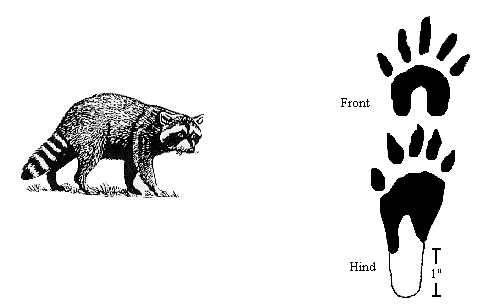

DISTRIBUTION: Statewide. Most common in the prairie pothole region and along wooded streams in eastern and central North Dakota.
HABITAT: Prefer wooded areas especially near water. Commonly found in brush patches in the prairie pothole country long distances from any densely wooded area.
LIFE HISTORY: Mating occurs in late January or February. The young are born in April or May after a gestation period of approximately 63 days. The average litter size is four although litters range from three to seven. The raccoon den is usually in a hollow tree in wooded areas, but in open country it may be in an abandoned hole and is usually located in a brush patch. The young raccoons remain in the den for eight to ten weeks. Young raccoons remain in a family group with their mother until fall and occasionally enter the winter hibernation period together.
Raccoons weigh from 12 to 30 pounds with occasional large specimens to 36 or 38 pounds.
Raccoons are chiefly nocturnal, although they are sometimes active during the daytime, especially on cloudy days and in the spring. They den up during cold weather but will come out during warm periods even in the middle of the winter.
Raccoons are very adept climbers and often climb trees when pursued by dogs. They are also very good swimmers and spend much of their time in the vicinity of water.
FOOD HABITS: Raccoons are omnivorous, which means that they eat almost anything. A partial list of foods would include frogs, fish, small animals, crayfish, birds, insects, corn, nuts, fruit, berries, eggs, and poultry.
SUGGESTED TRAP SIZE: No 1 1/2 double longspring, No. 2 doublelong spring, No. 2 double underspring, No. 2 or No. 3 jump trap.
SUGGESTED BAITS: Fish, including sardines, herring, smelt or any fresh fish; flesh, (fresh or tainted); crayfish; frogs; and honey.
The raccoon is a highly intelligent animal, but not difficult to trap. The raccoon's insatiable curiosity, unquenchable appetite, and willingness to eat almost anything make it quite susceptible to the good trapper.
Like the mink, the raccoon is commonly found near water. Creeks and rivers with their accompanying woody cover are preferred by 'coons. They also frequent lake shores and pothole edges, especially if there is a dense thicket of brush or lots of tangled grass nearby.
Blind sets near water are especially effective for raccoon as they like to work the water's edge looking for crayfish, clams or other food. Water sets for raccoon should be covered with an inch or two of water.
Raccoons have a very active mind and are an extremely curious animal. They will touch and investigate almost any bright object in the water. Trappers often take advantage of this habit by concealing all but the pan of a trap in the water and placing a bright piece of metal or aluminum foil on the pan.
A good blind set for raccoon is the "leaning log" set. Find (or place) a log that is partly in the water and partly on the bank. Cut a notch in the log to hold the trap so that it is just under the water. Raccoons like to wade out on such logs. This set is especially good on a small stream with the log crossing the stream where it is used as a bridge by the coon. This set also works well for mink.
The "pocket" set is useful in trapping 'coons although the hole must be larger than the one used for taking mink. Raccoons are often taken by concealing a trap under a piece of bait placed in a bush or small tree. "Cubby" sets are likewise effective as the raccoon must cross the trap site to get at the bait.

One of the most successful dry land sets for raccoons is the "dirt hole" set as described in the section on fox trapping. By using fresh fish or other raccoon bait, this set will take raccoon consistently. In making a dirt hole set for raccoon, it is not necessary to be as cautious as in setting for fox.
Raccoons are large and powerful animals. When caught, they lunge and leap about often breaking a weak trap chain or pulling loose from the trap. Many raccoon trappers prefer to use a drag rather than anchoring the trap to a stake. The drag (usually a piece of log or a long branch) gives when the animal pulls on the chain and doesn't allow the full force of the pull on the chain or trap. If a drag is used, it should be small enough so the animal can move it around but large enough to keep him from running off with it. Usually a drag will catch in the brush or grass and the animal does not go far. A grapple can also be used and works in much the same way. Drags or grapples should not be used in open country where there is no brush or thick grass for them to catch on.
Drowning sets are recommended for raccoon. When handling a live 'coon in the trap, be careful as they are quick and strong. Stun the animal with a rap on the nose with a stout stick, then kill it by drowning or by stepping on its chest and stopping the heart.